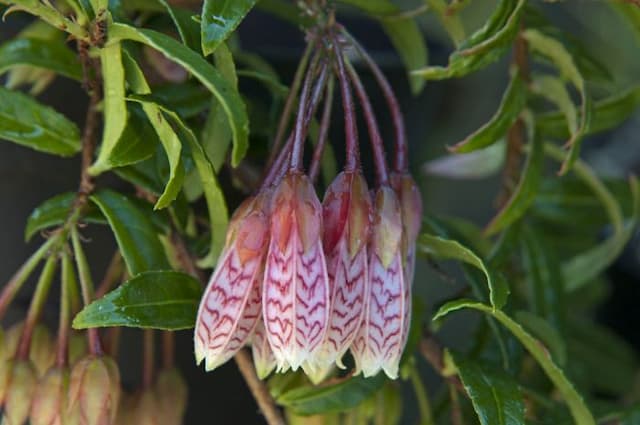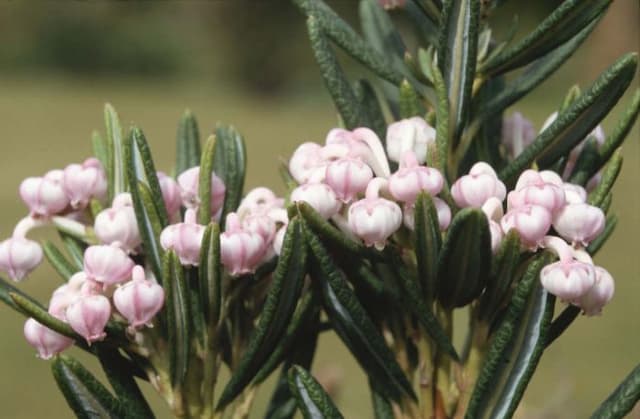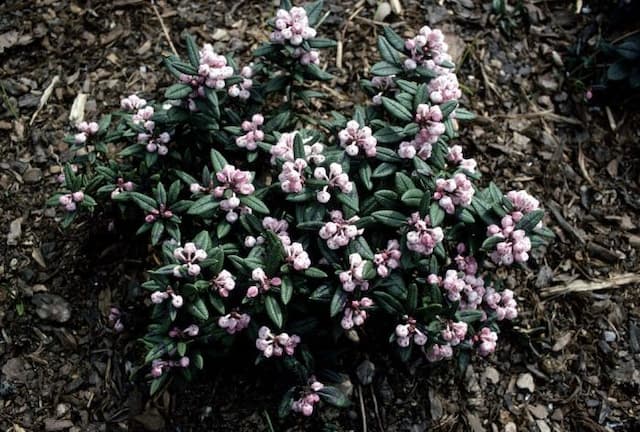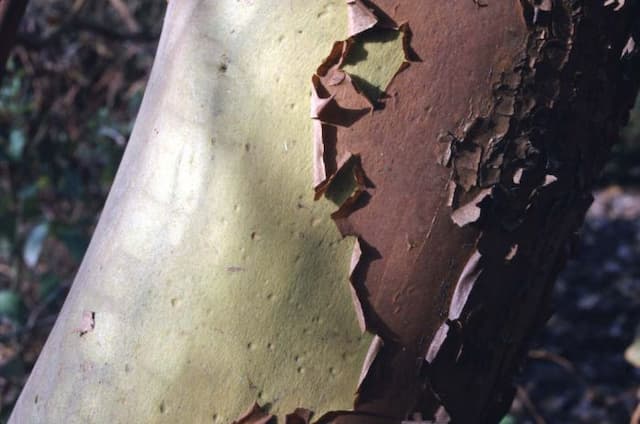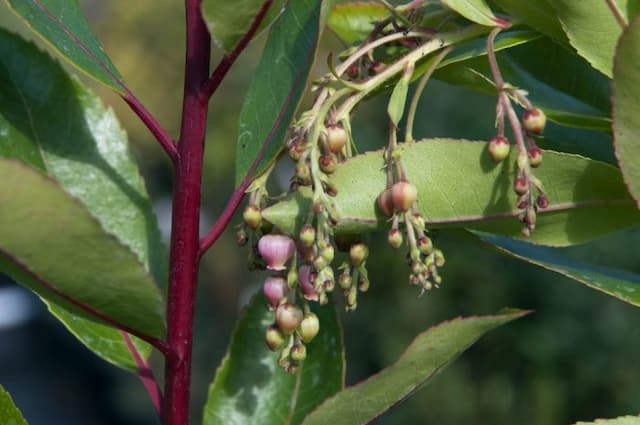Darley Dale Heath Erica × darleyensis 'Katia' (PBR) (Winter Belles Series)
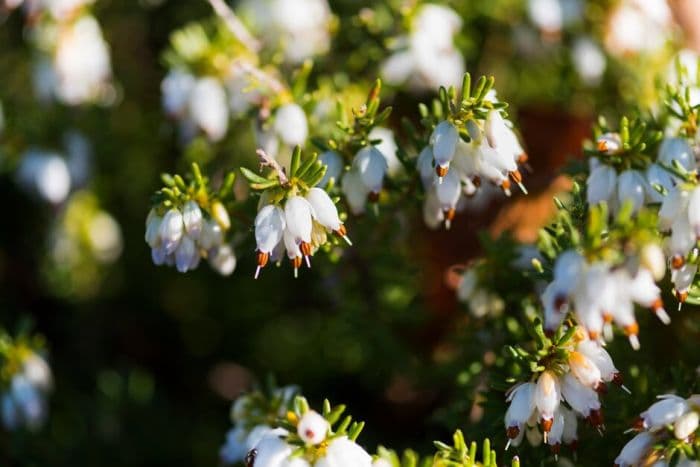
ABOUT
Erica × darleyensis 'Katia' is a beautiful plant belonging to the Winter Belles Series, commonly called winter heath. It boasts an attractive, dense, evergreen foliage that creates a backdrop for its delightful blooms. The leaves are small, needle-like, and typically dark green, contributing to a lush appearance throughout the year. As for the flowers, they present a truly eye-catching display. They are bell-shaped and come in varying shades, often showing a gradation of color, which range from deep pinks to lighter tones near white. The blooms densely cluster along the stems, giving the illusion of the plant being blanketed in color. The flowering period is quite long, covering the winter months and stretching into spring, providing a cheerful splash of color in the garden during a time when many other plants are dormant. The overall aspect of Erica × darleyensis 'Katia' is one of a compact, bushy mound. Its fine-textured foliage and profusion of flowers make it a favorite for garden enthusiasts looking to add a long-lasting touch of vibrancy to their landscape. It is an especially hardy selection, suitable for growing in a variety of conditions, and it tends to attract pollinators such as bees when in bloom, adding an extra layer of life to its surroundings.
About this plant
 Names
NamesFamily
Ericaceae
Synonyms
Darley Heath, Darley Dale Heath
Common names
Erica × darleyensis 'Katia' (PBR) (Winter Belles Series).
 Toxicity
ToxicityTo humans
The plant commonly known as Heather is not typically toxic to humans. There are no well-documented cases of poisoning from ingestion of this plant, as it is not commonly consumed. Therefore, there are no specific symptoms of poisoning associated with Heather for humans. However, as with any plant, individual allergic reactions or sensitivities may occur, so it is generally advisable not to consume plant material that is not known to be safe.
To pets
Heather is not generally considered toxic to pets. There are no common symptoms of poisoning reported in pets such as dogs and cats from ingesting this plant. Similar to humans, pets have varying degrees of sensitivity, and while the plant is not inherently toxic to most pets, it is still best to prevent your pets from consuming non-food plants as a precaution.
 Characteristics
CharacteristicsLife cycle
Perennials
Foliage type
Evergreen
Color of leaves
Green
Flower color
Pink
Height
1-2 feet (30-60 cm)
Spread
1-2 feet (30-60 cm)
Plant type
Shrub
Hardiness zones
7
Native area
Europe
Benefits
 General Benefits
General Benefits- Easy to grow: Erica × darleyensis 'Katia' is a low-maintenance plant that does well in a variety of soil conditions and requires minimal care once established.
- Drought tolerance: Once established, it can tolerate periods of drought, making it suitable for gardens with less available water.
- Winter color: As part of the Winter Belles Series, it provides vibrant color during the winter months when most other plants are dormant.
- Long flowering period: It has a long blooming season, often from late fall to early spring, providing extended interest in the garden.
- Attracts wildlife: The flowers can attract pollinators such as bees and butterflies to the garden, which is beneficial for the overall health of the ecosystem.
- Versatile landscaping: Suitable for rock gardens, borders, and ground cover, it offers a variety of landscaping uses.
- Erosion control: Its mat-forming habit can help stabilize soil and prevent erosion on slopes or banks.
- Frost hardiness: The plant is frost-hardy, surviving cold winter temperatures and frosts without requiring special protection.
- Evergreen foliage: It retains its foliage year-round, providing consistent coverage and structure in the landscape.
 Medical Properties
Medical PropertiesThis plant is not used for medical purposes.
 Air-purifying Qualities
Air-purifying QualitiesThis plant is not specifically known for air purifying qualities.
 Other Uses
Other Uses- Photography: Due to its bright, pink flowers, Erica x darleyensis is popular among photographers looking for rich, natural color contrasts in garden and nature photography.
- Fairy Gardens: This plant's delicate foliage and petite blooms make it an excellent choice for whimsical fairy garden designs.
- Eco-friendly Gift: Potted Erica x darleyensis can serve as a sustainable gift that encourages ecological awareness and appreciation for perennials.
- Culinary Decoration: The flowers can be used as a non-toxic decoration for cakes and pastries, although they are not edible and should be removed before consumption.
- Art Supplies: The colorful blossoms can be pressed and used by artists and crafters in creating natural, botanical art pieces and homemade paper.
- Natural Dye: While not commonly used, the flowers have the potential to be used in creating natural dyes for fabrics.
- Seasonal Celebrations: Branches of Erica x darleyensis can be incorporated into winter wreaths and floral displays for holiday decorations.
- Study Subject: Botany students and enthusiasts can use this particular hybrid as a case study for understanding hybridization and cultivar development.
- Ice Cubes: Flowers can be frozen into ice cubes to add a touch of elegance to special beverages, although the cubes should not be consumed due to potential plant sensitivities.
- Land Art: This plant can be used in the practice of land art, where natural components are arranged into artistic creations outdoors.
Interesting Facts
 Feng Shui
Feng ShuiThe Heather is not used in Feng Shui practice.
 Zodiac Sign Compitability
Zodiac Sign CompitabilityThe Heather is not used in astrology practice.
 Plant Symbolism
Plant Symbolism- Endurance: As a hardy plant that can withstand various conditions, Erica × darleyensis, commonly known as winter heath or heather, symbolizes the ability to endure challenging situations.
- Protection: Traditionally, heather plants are believed to possess protective qualities, warding off harm and negative energies.
- Good Fortune: In some cultures, winter heath is associated with luck and is thought to bring good fortune to those who have it.
- Solitude: Heather plants thrive in solitary places with barren landscapes, representing a love for seclusion and contemplation.
- Admiration: With its delicate flowers and persistent nature, winter heath is often given as a token of admiration and respect.
 Water
WaterHeather should be watered deeply to ensure the soil is thoroughly moistened, but the frequency will depend on the climate and soil conditions. Typically, during the growing season, watering should be done approximately once or twice a week, ensuring that the plant receives about 1 inch of water each time. In particularly dry conditions, you may need to increase watering frequency and provide up to 2 gallons per plant every week. It's important to reduce watering in the winter when the plant is dormant, potentially scaling back to once every two weeks, depending on rainfall and soil moisture. Overwatering can lead to root rot, so always check the soil moisture before watering.
 Light
LightHeather thrives in a location that receives full sun to partial shade. It performs best when it gets at least 4 to 6 hours of sunlight daily. However, in areas with very hot summers, it benefits from afternoon shade to prevent scorching. The ideal spot would be one that offers morning sunlight with some protection from the intense late-day sun.
 Temperature
TemperatureHeather is quite hardy and can handle temperatures as low as 10 degrees Fahrenheit, making it suitable for many climates. The plant prefers cooler conditions and will thrive in temperatures that typically range from 60 to 70 degrees Fahrenheit. Heather is generally resilient to the cold but may need protection in zones where temperatures frequently drop below the survival limit.
 Pruning
PruningHeather benefits from pruning to stimulate fresh growth and maintain a dense, neat appearance. Prune immediately after flowering to avoid cutting off next year's buds, typically by removing about the top third of the plant. Light shaping every year or two is often enough to keep the plant looking its best. If heather becomes woody and open, more drastic pruning may be necessary to rejuvenate the bush.
 Cleaning
CleaningAs needed
 Soil
SoilDarley Dale heath thrives in a mix containing equal parts of peat, sand, compost, and loamy soil, with a preferred pH range of 4.5 to 5.5, which is mildly acidic.
 Repotting
RepottingDarley Dale heath should be repotted every 2-3 years to refresh the soil and accommodate root growth; younger plants may need more frequent repotting.
 Humidity & Misting
Humidity & MistingDarley Dale heath does best in moderate to high humidity environments but is fairly adaptable to less humid conditions as long as the soil moisture is adequate.
 Suitable locations
Suitable locationsIndoor
Place Darley Dale heath in bright, indirect light and keep soil moist.
Outdoor
Plant Darley Dale heath in well-draining soil, partial sun.
Hardiness zone
7-9 USDA
 Life cycle
Life cycleErica × darleyensis 'Katia', commonly known as Heather or Winter Heath, starts its life cycle as a seed, though it is often propagated via cuttings for cultivar consistency. Once germinated or rooted, it enters the growth stage, developing a dense foliage of needle-like leaves and establishing its root system. As it matures, typically within 2-3 years, Heather progresses to the flowering stage, producing pink to white bell-shaped flowers during late winter to early spring. Pollinated flowers may lead to seed production, allowing the plant to spread, although cultivars like 'Katia' are usually propagated vegetatively. After several years, the plant may enter a maintenance phase, where growth slows and care focuses on preserving the plant's health through pruning and protection from pests. Finally, after many years, usually more than a decade, the plant will reach the end of its life cycle and decline.
 Propogation
PropogationPropogation time
Early Spring
Propogation: The most popular method of propagation for Erica × darleyensis 'Katia', commonly known as Heather, is through semi-ripe cuttings. This technique is best performed in late summer. To do this, select healthy, semi-ripe shoots and cut them to a length of about 2 to 3 inches (5 to 7.5 cm). Remove the lower leaves and dip the cut end into rooting hormone powder to encourage root development. Plant the cuttings in a mixture of peat and perlite or a specialist cutting compost and keep them in a well-ventilated, shaded place until roots have developed, which can take several weeks. Once rooted, the cuttings can be transferred to individual pots and eventually planted out in the garden.
